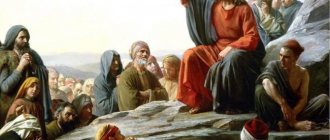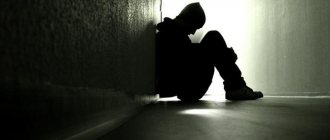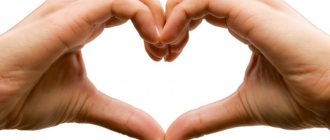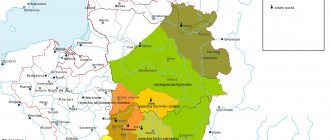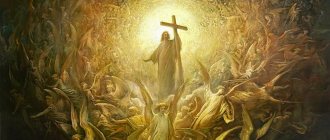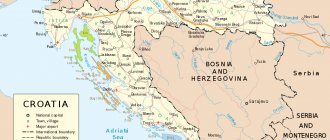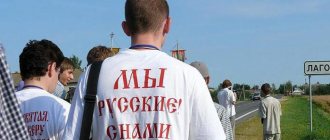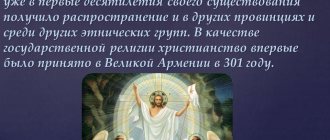Principles and laws
Christianity itself arose in the 1st century. It originated in Palestine, where several beliefs originated, and owes its origins to the more ancient Judaism with its monotheistic God and the Old Testament.
The emergence of Christianity is associated with the emergence of the belief that the newcomer Jesus Christ is the very Son of God whom believers have been waiting for. Judaism does not recognize it as such, which distinguishes both religions.
The essence of all Orthodox dogma, its source is faith in the Lord, who is the bearer of the highest wisdom. The main goal of any believer should be to earn eternal life in heaven after death. To do this, during his lifetime he must follow the commandments of the Lord and confess His teaching.
The main points of the worldview are as follows:
- Mercy: providing help to those in need, alleviating the suffering of the unfortunate. A merciful person does something pleasing to the Lord.
- Forgiveness: an equally important aspect of life. This is not about forgetting the offense, but about giving God the right to punish the offenders himself. Without forgiveness of everyone who offended a Christian, he will not be able to go to heaven after death.
- Perseverance: a person is full of faith and hope for God’s help, completes any task and does not lose heart. This is necessary to spread goodness and faith.
- Watchfulness: This is about being open to good works and serving the Lord. A person's soul and conscience should not sleep when someone needs help. It is an important resource for the believer.
- Church: is the “conductor” of teaching from God to man. It plays an important role in the life of a believer: people come here for confession and communion, the Church helps those who are confused and teaches those who want to know what it means to be an Orthodox person.
- Confession: a sincere story about your sins, repentance for them and receiving forgiveness. It is one of the obligatory sacraments. If a person does not have time to confess, he will not be able to get into Heaven.
- Sunday: the day when a believer should cast aside everyday worries and think about the soul and the Lord. At this time, it is customary to visit the temple and pray.
In addition, the life of a believer is influenced by the 10 commandments, the formation of which is attributed to Moses. They form the basis of all Christianity and do not differ in different branches.
Dogmas of teaching
The teaching itself is based on the Holy Scripture (Bible) and Holy Tradition, which includes the decrees of the Ecumenical Councils. The main dogmatic document that is used in everyday life is the Nicene-Constantinopolitan Creed. This is a confessional formula that represents the most complete disclosure of the doctrine of the Trinity and a number of important issues.
Orthodoxy is based on several dogmas:
- Only true believers will be saved.
- For the forgiveness of sins it is necessary to be baptized.
- God is represented in three persons - Father, Son, Holy Spirit. They are equal to each other; all three must be worshiped equally.
- God takes on the image and likeness of man.
- Jesus is the only begotten of God. He always lived, but came to Earth through birth from the Virgin Mary.
- The Holy Spirit is equal to God. It comes from God and connects him with Christ.
- Jesus is the Head of the faithful Orthodox Church.
- The resurrection of Jesus is true. People should be grateful to him for the sacrifice he made and look forward to the second coming of Christ.
At the Fourth Council, a ban on changes to existing dogmas was adopted. It is still being performed.
Orthodox countries
It is very difficult to find out the exact number of Orthodox Christians in the world; we can only talk about approximate data; in 2000 there were about 125 - 180 million people in the world.
Countries with many Orthodox Christians:
- Russia: 101 million followers;
- Greece: 10 million (98% of the country's total population);
- Ethiopia: 36 million;
- Ukraine: 35 million;
- Romania: 19 million;
- Serbia: 6.7 million;
- Bulgaria: 6.2 million;
- Belarus: 5.9 million;
- Egypt: 3.9 million;
- Georgia: 3.8 million
Appearance of the name
The very name “Orthodoxy” is literally translated from Greek as “correct glorification” or “correct opinion.” In theological literature, the term denotes the teaching approved by the Catholic Church; its opposite is “heterodoxy” or “heterodox,” that is, the views of heretics or those that the Church rejected.
The word “Orthodoxy” itself was mentioned already in the 2nd century in the texts of apologists (successors of the apostles), for example, in Clement of Alexandria. As a term, it was established in the 3rd century by the historian and bishop Eusebius of Caesarea, and was first officially recorded in the middle of the 5th century in the acts of the IV Ecumenical Council. Beginning in the 6th century, Orthodoxy began to designate religious views that closely correspond to the teachings of the Church and the Gospel.
In Rus', the term appears in several early written sources:
- In the story of Bygone Years as part of the Laurentian Chronicle (1377).
- In an early copy (copy) of “The Sermon on Law and Grace” (early 11th century) by Metropolitan Hilarion. A copy was made in the second half of the 15th century.
Interesting fact: in Russian, the terms “Orthodoxy” and “Orthodox” are synonymous and are not used simultaneously, as, for example, in Judaism.
History of religion
Until 1054, all Christianity was united; there was no division between Orthodoxy and Catholicism. The teaching itself dates back to apostolic times or to the 1st century. It was formed on the basis of the Ecumenical Councils - meetings of the episcopate at which important issues were resolved.
The following Councils were significant for Orthodoxy:
- 325 - First (Nicene). The Nicene Creed was compiled (all 3 hypostases were recognized as consubstantial - God the Father, Son and Holy Spirit), and beliefs that denied it were condemned.
- 381 - Second. The equality of all three hypostases was approved, and the final edition of the Nicene Symbol was drawn up.
- 431 - Third (Ephesian). The Virgin Mary began to be called the Mother of God, the heresies of Pelagius and Nestorius were condemned.
- 451 - Fourth (Chalcedonian). The accepted dogma is that Christ is true God and man, similar to people, but without sin. Some heresies are condemned.
- 553 - Fifth. A number of teachings and their teachers, as well as some scientists, including followers of the Alexandrian theological school (Plato, Origen and others), were condemned.
- 680 - Sixth. Heresies are condemned. Due to the increasing decline in discipline and piety, another council was convened at the same time, which adopted 102 canons for the Church in the East. Both Councils met in the same place (a palace hall with vaults - trulle), which is why they were combined into one Trullo Cathedral.
- Middle VIII - not numbered. Convened for the sake of the “Accurate Exposition of the Orthodox Faith” - the first systematization of the teaching, which was compiled by John of Damascus.
- 787 - Seventh. Icon veneration has been returned again. It is accepted that those who worship an icon worship the person depicted on it. This worship passes on to the written saint.
- March 843 - Triumph of Orthodoxy. Church celebrations that took place after the Council of Constantinople, at which the veneration of icons was restored. At the gathering, heretics are anathematized.
- 879 - Eighth (Local). Patriarch Photius I was again returned to the patriarchal throne, and any changes in the Creed were condemned.
In 1054, the final split of Christianity into Catholicism and Orthodoxy occurred. Today, Orthodox priests do not recognize any Councils convened after the schism, even if Orthodox patriarchs were present.
Today, the largest autocephalous Orthodox Church is the Russian Orthodox Church (Russian Orthodox Church) or the Moscow Patriarchate. This is a Russian center, which is the bearer of philosophy and traditions of religion.
Orthodoxy in Russia
About 70% - 80% of the Russian population are Orthodox.
A very difficult time for the Russian church was after the fall of the monarchy (after the revolution of 1917). Then they were forced to convince people of the truth of atheism, which led to the plunder of many temples.
Find out who an Atheist is.
The collapse of the USSR in 1991 put an end to the persecution of believers and the Russian Orthodox Church began its smooth restoration.
Orthodoxy in Rus'
Rus' decided to improve its relations with Byzantium (i.e. the Eastern Roman Empire, capital Constantinople), and it was decided to convert to Orthodoxy.
In Rus', Christianity became the official state religion around 988. Behind this was Prince Vladimir Svyatoslavovich (Baptist of Rus').
Find out more about the Baptism of Rus'.
Some differences
Often, believing people confuse the definitions of Orthodoxy and Christianity. What is the difference between them can be briefly suggested by the phrase “All Orthodox are Christians, but not all Christians are Orthodox.” The fact is that all Christianity is divided into several branches, the largest of which are Catholicism, Protestantism and Orthodoxy.
You can see how the 3 largest branches of Christianity differ, what their features, specificity and structure are, using the table.
| Provisions | Catholicism | Protestantism | Orthodoxy |
| Attitude to secular power | The head of the Church (the Pope) has religious and political power | Eager to cooperate | Throughout this time, relationships have changed many times from cooperation to expulsion or submission. |
| Attitude towards people | Individuality is important | Interfering in the affairs of neighbors and helping each other (if the person has not asked for it) are not welcome | All people are brothers and sisters |
| Soul after death | The soul goes through Purgatory and is purified | Christ has already atoned for the sins of all people with his death, and therefore earthly affairs are not so important | The soul goes to Hell or Heaven depending on the deeds done during life |
| Cross of the Lord | It has 4 ends - a “standard” cross. The legs are nailed with one nail, stacked on top of each other. Usually depicted with a martyr's expression | Neither the Cross nor the icons are recognized | It has 8 ends - 4 ends of a “standard” cross and 2 horizontal bars (a sign above the head and a footrest). The legs are nailed with 2 nails. Jesus is depicted with outstretched arms, as if embracing the world |
| Baptism | Baptism is performed on children at least 7 years old. The ritual involves pouring holy water or sprinkling | Can only be taken by adults who have made their choice | Both infants and adults can be baptized. For the ritual, you need to immerse yourself in a font of holy water three times, then take communion and perform confirmation. |
| Services | Priests are endowed by God with special powers | Do not need special places or priests: the latter lead an ordinary life | The priest does not possess divine power; the Lord himself will appear in the temple during the service |
| Marriage | Does not support divorce, priests must adhere to celibacy | Divorce is possible in 2 cases - the infidelity of a spouse or the abandonment of an unbeliever by a believer | Divorce is allowed in some cases, some ministers are allowed to marry |
| Mother of God | Immaculate, without sin | The Virgin Mary is considered an ordinary person | Is a person who committed original sin |
| Holy Spirit | Comes from the Father and the Son | Coming equally from the Father and the Son | Coming from the Father and transmitted to the Son |
| Holy Scripture and Holy Tradition | Have equal importance | Have no authority | Scripture is part of Tradition |
In total, there are more differences between the main movements of Christianity, but even from the main ones it is clear that the basis of the teaching is the same, and the differences are mostly small or relate to services, sacraments or terms. For example, Catholics consider the Pope to be the head of all Christians, which, for obvious reasons, is rejected by the Orthodox branch.
It is important to note that Orthodoxy is tolerant of other religions, but considers them heretical and their followers unworthy of the Kingdom of God. However, Catholics and Protestants may not be deprived of the Lord's blessing, since they also believe in him, albeit in a slightly different way.
It is worth noting the differences from the Old Believers. In the 17th century, a split in the Church occurred in Russia after Patriarch Nikon carried out reforms. People who did not accept the innovations began to be called Old Believers. They refused to hold services according to the new rite and were not recognized by the Orthodox Church. Later, the Old Believers moved greatly away from the official faith in liturgical singing, icon painting, bowing, life and culture, and also divided into several smaller branches. The Moscow Patriarchate does not recognize the Old Believers.
The religion Orthodoxy today is the third largest branch of Christianity - one of the main world religions. It is common in Eastern European countries, including Russia, where about 40% of all Orthodox Christians live. In many countries where religion is not the main or official religion, large communities and dioceses have been established.
Orthodox traditions
There are many Orthodox holidays in Russia. For example: Cheese holiday (Maslenitsa), Trinity Day, Christmastide, Christmas and many others.
In honor of the holiday, from generation to generation Orthodox Christians hang decorations in their homes for one holiday or another. But at every celebration you can invariably see icons on corner shelves.
In addition to icons and other festive decorative items, Orthodox Christians set a beautiful table to celebrate the holiday with friends and family. And on the morning of the holiday it is customary to go to temples.
